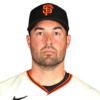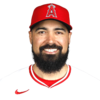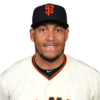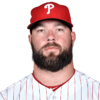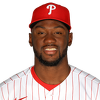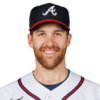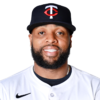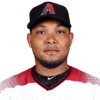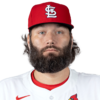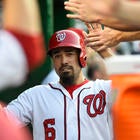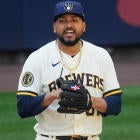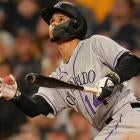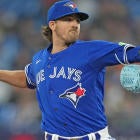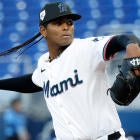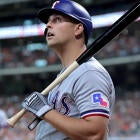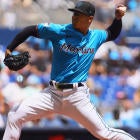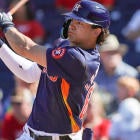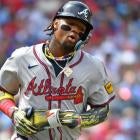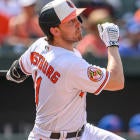By far the most difficult category to actually describe is the sleeper category. Definitions differ greatly depending on who you ask.
Do these guys have to be relative unknowns? ADP requirements? What differentiates them from breakouts?
You get the point.
I'm not big on strict requirements but for this version I tried to focus on players I think will greatly outperform expectations. I also tried to limit it to players who won't likely be drafted in the first six rounds. We'll start with one that may not be drafted at all.
Travis Shaw had a pretty terrible 2016 campaign after a surprisingly successful rookie season. Now he heads to the Milwaukee Brewers, which is about as good as it gets for a left handed hitter. Miller Park has consistently ranked as one of the top 5 parks for LH home run hitters according to Fangraphs while Fenway has generally been regarded as one of the worst.
Shaw has a a 44 percent fly ball rate and a 32 percent hard contact rate which matches the profile of several hitters right around a 20 HR pace. But that's in a normal park. Miller Park has consistently been home to a higher HR/FB rate than you would expect. Ryan Braun led baseball with a 28 percent rate last year and even Scooter Gennett was at 10.5 percent.
To explain what all that means, with 600 PA Shaw would be expected to hit around 400 balls in play. At his career average, that would mean 176 fly balls. If he has Braun's HR/FB rate that would be 49 HR. That's ridiculous. If he has Jonathan Villar's rate he would hit 35 HR. The most likely scenario is that Shaw's HR/FB rate is around the Brewer's team average of 15.6 percent which would be a 27 homer season. Considering you can draft him in the last round of the draft, that would be great value and his upside is even higher.
Robbie Ray almost snuck his way into my breakout column because I absolutely think there's a good chance he's doing something he's never done before. Then you look at that 2016 strikeout rate and it's hard to say he didn't already break out. Yes, he walks too many batters and that hampers both his WHIP and his innings. I hope that changes but I can't really make an argument that he'll choose now to start pounding the zone.
What I can argue is that his luck should be better and even a small change in that area. Ray's .352 BABIP against was the highest mark in baseball and helps explain his WHIP and innings problem. His 68.7 percent strand rate was the 12th lowest in baseball. That is hurt by his BABIP but should be helped by his K rate. Only two of the bottom 14 in that category struck out more than a batter an inning. Finally, his HR/FB rate was the 10th highest in baseball. That helps explain why his ERA was nearly a run and a half higher than his xFIP.
Ray may just be the National League Michael Pineda, but he didn't look like it in 2015. I would bet on his luck bouncing back, which should make him a solid No. 4 starter. If he makes any improvement in that walk rate as well, the sky is the limit.
Anthony Rendon is the most likely player to get drafted too high to stay on this sleepers list in March. Rendon had a decent year in 2016, but his final numbers were held down by terrible batted ball luck in the first half. We're going on three years now of believing Rendon could make the leap into the second tier of third basemen. Let's talk about what that would look like.
Excluding his injury-plagued 2015 campaign, Rendon has established a pretty reasonable base of 20 HR, 15 SB, with 80+ runs and RBI. That's pretty outstanding but he's also a hitter with a hard contact rate consistently above 35 percent and a HR/FB rate that has never topped 10 percent. There's a every reason to believe that he has a power outbreak in his future.
With Rendon's on base skills, a career year in the power department could easily vault him into the top 5 third basemen. It would also likely move him up in the Nationals order, which would help his run production numbers.
If Yangervis Solarte hadn't missed so much time injured last season maybe people would recognize how valuable he has become. Solarte hit 15 HR in just 109 games last season and finally saw his BABIP rise to a level that was somewhat reasonable. Even still, his career-high .306 BABIP was not exactly high for a hitter of his profile.
Solarte already possessed excellent contact skills, as evidenced by low K rate. Adding 20 HRs and 80 RBIs will give him a chance to sneak into the top ten at an extremely deep position. The depth of 3B makes it easy to wait if you miss out on the first round talent and take someone like Solarte long after everyone else has filled the position.
Just about any catcher outside of the top six could be a sleeper because of how uninspiring the position is after that. Rupp won't be drafted in a lot of one catcher leagues, but there's an argument to be made that he should be considered as soon as the top six are off the board.
Rupp's 16 HR and 54 RBI in 104 starts last year project out to 21 and 73 over 140 game pace. Only two catchers had more home runs and more RBI than that in 2016. The bigger problem for Rupp comes in his walk and strikeout numbers, which is why he's more likely to make the leap into the top ten in Roto leagues than he is in points.
Odubel Herrera had a ridiculous start to 2016, when he led baseball in walks. While no one thought that was going to last it was encouraging to see him cut his strikeout rate down to 20 percent and if that can hold up in 2017 he's going to be underrated for a third straight season.
The improved walk rate and lowered K rate really helped Herrera's value in points leagues but his true value lies in Rotisserie leagues where he should be a four category contributor. Herrera will provide double digit home runs while hitting near .300, swiping 20+ bags and scoring 80+ runs atop a mediocre Phillies lineup. That's easily good enough to make him a starting outfielder in just about any league.
We've spent plenty of time in the office debating the Wade Davis trade and where he'll rank amongst closers on his new team. What seems to get lost is the opportunity this affords Kelvin Herrera. Herrera was outstanding in a setup role last season with a K/BB ratio that was amongst the best in baseball. Much of that success was credited to his new slider. Opposing hitters hit .133 against Herrera's slider with a 30 percent whiff rate.
If Herrera can maintain his elite strikeout numbers and lockdown the same percentage of saves Wade Davis did, he has a chance to vault into the top five closers. Because of his limited track record closing games out, he'll be available 5-10 rounds after the first closers are taken.
Collin McHugh may never be as good as he was in 2014 when he posted a sub-3.00 ERA and struck out more than a batter per inning, but he won't likely be as bad as he was last season either. McHugh surrendered a .338 BABIP against and 1.22 HR/9 despite the fact that his hard contact allowed was a pretty mild 30 percent. What's maybe even more relevant is he still won 13 games. I would expect McHugh to get his ERA back below 4, while throwing 200 innings in 2017. On this Astros team that's likely good for 15+ wins and a huge value where he'll be drafted.
Carlos Santana is seemingly always a sleeper mostly because of his unimpressive batting average I suppose. Each year he outperforms his ADP in points leagues because he does such an exceptional job of getting on base. In 2016 he took a leap in Rotisserie as well, by slugging 34 home runs. He also cut his strikeout rate to 14.4 percent, which led to an improved average. If that strikeout rate is the new norm, Santana should be viewed as a top ten option in points leagues and startable 1B in Roto as well.
Josh Reddick made a transformation in his time in Oakland to the point that he's a completely different hitter than when he arrived. In 2012 he posted a .221 ISO but struck out 22 percent of the time. In the past two seasons his power has nosedived (30 HR in more than 1,000 PA) but he has dropped his strikeout rate down to 12 percent. Now he heads to the Houston Astros to hit in a much better lineup and ballpark.
If Reddick can just get back to his 2015 numbers (20 HR, 10 SB) and stay healthy he'll be a valuable commodity in his new environment. The Astros should give him every opportunity to get back near his run production numbers from 2012 even if he's never going to hit 30 HR again.
I wonder if maybe Yasmany Tomas gets graded on a different curve because he didn't come up through the minors as a prospect and we didn't have time to get all excited about him. Because what he's done in two seasons should have us pretty excited. As a 24 year old rookie he struggled to adjust to big league pitching and posted a BABIP-assisted .273 batting average but only a .706 OPS. He was also awful in the field and many speculated he wasn't going to make it.
Flash forward to 2016 and Tomas saw the expected crash in his BABIP, but still hit .272, with an .821 OPS and 31 home runs. So now he's entering his prime, coming off a 30 homer season and once again everyone sells him short because there's no way he can maintain the 25 percent HR/FB rate he had last season. That all but ignores the fact that he also made improvements in both his walk rate and his strikeout rate in his second season.
There is no guarantee that Tomas continues to improve, but it shouldn't be ruled out either. Even if he doesn't, 30 home runs is a realistic expectation if he gets 600 PA and maintains a hard hit rate anywhere close to last year's 41 percent.
As the old saying goes, nobody washes a rental car. I feel like that's instructive when it comes to Lance Lynn's 2017 Fantasy value. Lynn will be nearly 18 months removed from Tommy John surgery at the start of the 2017 season and he'll also have one season left on his contract with Cardinals. In other words, Lynn has every motivation to prove he is back to his old self and the Cardinals have no motivation to save him for anything beyond 2017.
Lynn had been a remarkably consistent pitcher for the Cardinals before his injury. He's a mid-3 ERA pitcher that strikes out nearly a batter per inning. He'll be available very late in drafts and I'd rather draft him than his teammate Adam Wainwright.









